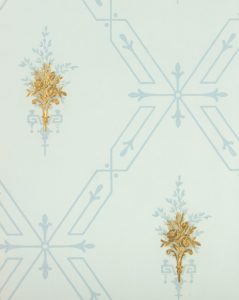With the repainting and interior spruce up at the Hexagon House, wallpaper has been a decorating topic of speculation. The quick and low-tech paint analysis revealed very few paint layers in most rooms, further fueling the suspicions the Hexagon House was likely wallpapered in almost every room for most of its history – as you would expect from a house built during the wallpaper boom of the 1870s. While having a bit of fun daydreaming about what patterns might have adorned the walls once upon a time, an article on a deadly book of wallpaper samples, appropriately titled Shadows from the Walls of Death popped up in my news feed.

The wallpaper samples are all genuine papers that were printed in the 1870s, and their deadly reputation comes from the arsenic used to produce the green hues in the patterns. The arsenic would flake off when brushed or be released when the paper became damp and spread microscopic amounts of the poison into the home. Healthy adults may not have noticed any ill-effects, but children could be killed from even a small amount of the particulate. Many people of the time dismissed the fear over green pigments as hysteria, and the exact cause of the poisoning took well over one hundred years to solve.
You can read more about the origin and spread of the vivid green, arsenic-laden paints and dyes from Europe to the United States at Jane Austen’s World blog and Smithsonian.com.
Once you have had your fill of the verified deadly wallpaper, you might also want to page through the trade catalogs on Archive.org to see more wallpaper samples and color plates of suggested room designs from 1900-1960. You may also enjoy some window shopping of other vintage patterns at Designyourwall.com. Those patterns probably won’t kill you, at least from arsenic.